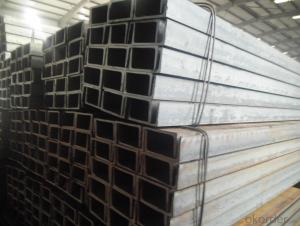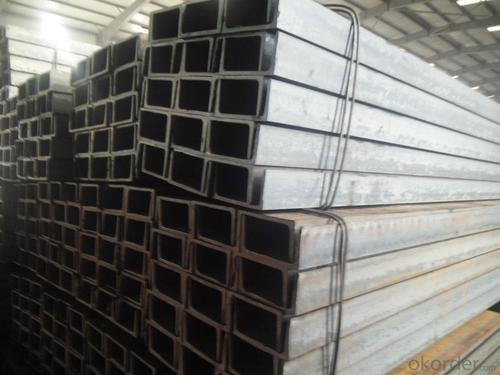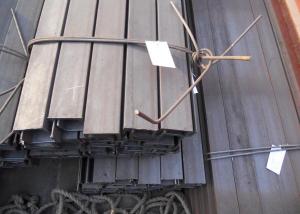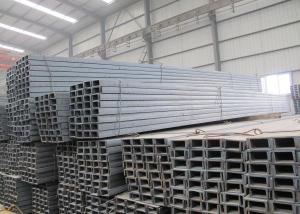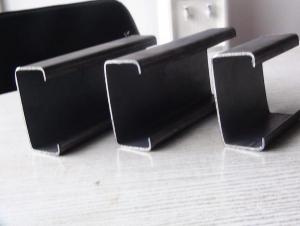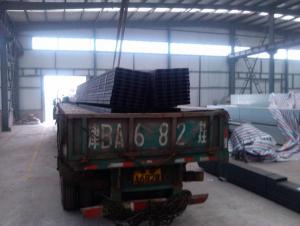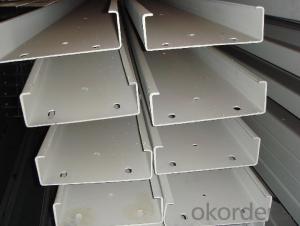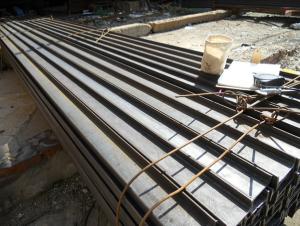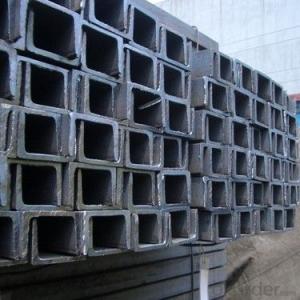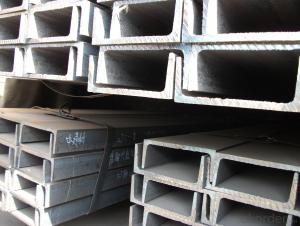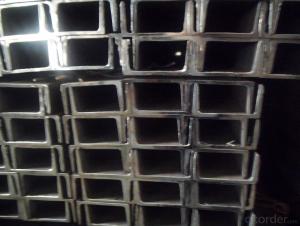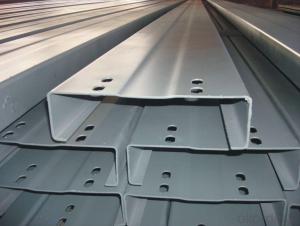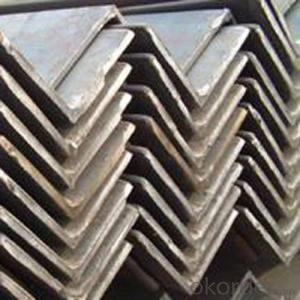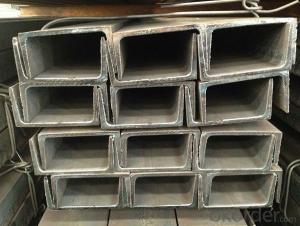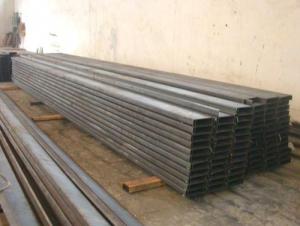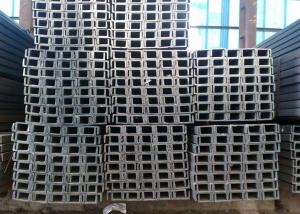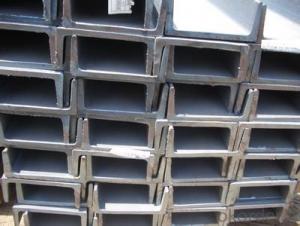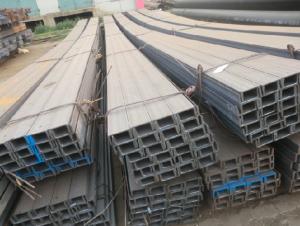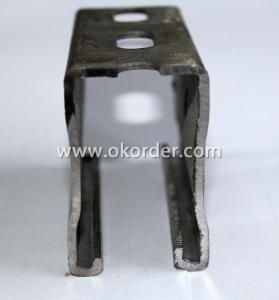JIS Standard Hot Rolled Steel U Channels for Constrction
- Loading Port:
- Tianjin
- Payment Terms:
- TT OR LC
- Min Order Qty:
- 25 m.t.
- Supply Capability:
- 200000 m.t./month
OKorder Service Pledge
OKorder Financial Service
You Might Also Like
Specifications of JIS Standard Hot Rolled Steel U Channels for Constrction:
1. We are definitely speciallizing in manufacturing and supplying channel steel as per japanese standard, which is characterised with high mechanical strength and competitive prices.
2. The sections in details are as followings in the table-1
JIS CHANNEL | Standard h | Sectional b | Dimension s | t | Mass: Kg/m |
(mm) | (mm) | (mm) | (mm) | ||
50x25 | 50 | 25 | 3.0 | 6.00 | 2.37 |
75X40 | 75 | 40 | 3.8 | 7.00 | 5.30 |
75X40 | 75 | 40 | 4.0 | 7.00 | 5.60 |
75X40 | 75 | 40 | 4.5 | 7.00 | 5.85 |
75X40 | 75 | 40 | 5.0 | 7.00 | 6.92 |
100X50 | 100 | 50 | 3.8 | 6.00 | 7.30 |
100X50 | 100 | 50 | 4.2 | 6.00 | 8.03 |
100X50 | 100 | 50 | 4.5 | 7.50 | 8.97 |
100X50 | 100 | 50 | 5.0 | 7.50 | 9.36 |
125X65 | 125 | 65 | 5.2 | 6.80 | 11.66 |
125X65 | 125 | 65 | 5.3 | 6.80 | 12.17 |
125X65 | 125 | 65 | 5.5 | 8.00 | 12.91 |
125X65 | 125 | 65 | 6.0 | 8.00 | 13.40 |
150x75 | 150 | 75 | 5.5 | 7.30 | 14.66 |
150x75 | 150 | 75 | 5.7 | 10.00 | 16.71 |
150x75 | 150 | 75 | 6.0 | 10.00 | 17.90 |
150x75 | 150 | 75 | 6.5 | 10.00 | 18.60 |
150x75 | 150 | 75 | 6.5 | 10.00 | 24.00 |
200X80 | 200 | 80 | 7.5 | 11.00 | 24.60 |
Table-1
3. The mechanical property of JIS Channel in the table-2:
Grade | Yield Strength,N/mm² | Extension Strength N/mm² | |||
Thickness of Steel,mm | |||||
≦16 | >16-≦40 | >40-≦100 | >100 | ||
SS330 | ≧205 | ≧195 | ≧175 | ≧165 | 330-430 |
SS400 | ≧245 | ≧235 | ≧215 | ≧205 | 400-510 |
SS490 | ≧285 | ≧275 | ≧255 | ≧245 | 490-610 |
SS540 | ≧400 | ≧390 | - | - | ≧540 |
Table-2
4. The chemical composition of JIS Channel in the table-3
Grade | Element(%) | |||
C | Mn | P | S | |
SS330 | -- | -- | ≦0.050 | ≦0.050 |
SS400 | ||||
SS490 | ||||
SS540 | ≦0.30 | ≦1.60 | ≦0.040 | ≦0.040 |
Table-3
Usage of JIS Standard Hot Rolled Steel U Channels for Constrction:
1.The JIS channel can be devided into two kinds, namely common channel steel and light channel steel. The sizes of hot rolled common channel steel range from 5# to 40#. Meanwhile, the channel steel can be divided into cold forming sectional equal channel steel, cold forming sectional unequal channel steel, cold forming inner edge channel steel and outer edge channel steel.
2.The JIS channel is usually used for arch-itechtural structure, and they could be welded in order to support or hang a vari-ety of facilities. They are also usually used in combination with I beam. The channel steel with sizes under 14# is usually applied to construction engineering, as purline, while the channel steel with sizes above 16# is more likely to be used in building vehicle chassis structure and mechanical structure. Furthermore, the channel steel in sizes above 30# are target at building bridge structure, as tension bar.
3.In a word, the channel steel must possess perfect welding property, riveting property and mechanical property and so on.
Package & Delivery of JIS Channel:
1.The JIS channel will be packed in bundle with steel wire at each end of every bundle and color marking in order to help the customer to recognize his goods more easily at sight.
2. And the JIS channel could be loaded into 20ft or 40ft container, or by bulk cargo.If the weight of each bundle reaches more than 3.5 mt, the loading by break bulk cargo should be choosed.When the weight of each bundle reaches less than 3mt, the loading by container should be choosed.
3.As for the transportaion from mill to loading port, the truck will be usually used. And the maximum quantity for each truck is 40mt.
4.All in all, we could do in accordance with customer's request.
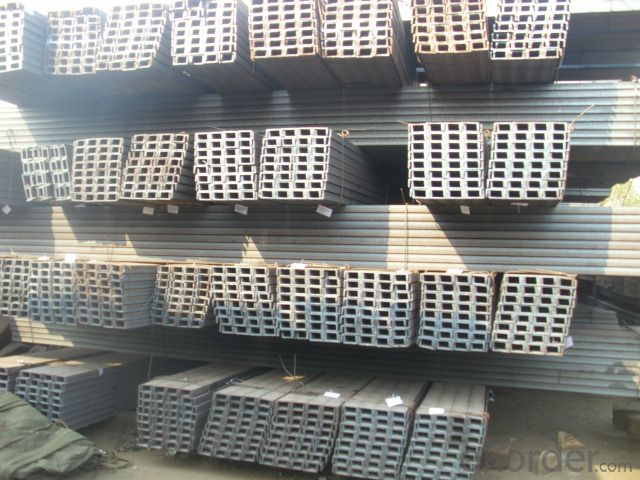
Production Flow of JIS Standard Hot Rolled Steel U Channels for Constrction:
1.The steel billet shall be heated in the high temperature furnace.
2. The heated steel billet shall be rolled five to nine times with the aim of shaping the general figure of steel u channel.
3. The rolled steel channel should be put onto the cooling bed to make the temperature low.
4. The JIS Channel should be straighted on the straightener.
5. The straighted steel u channel will be cut into meters by saw, as per customer's requirements.
6. At the last part of production, the channel steel must be tested in order to confirm that the finished products are completely free from crack, pore, slag, scab or fold on the surface.
- Q: Can steel channels be used in shipbuilding?
- Yes, steel channels can be used in shipbuilding. Steel channels are commonly used in the construction of ships due to their strength, durability, and versatility. They provide structural support and are used in various applications such as framing, stiffening, and reinforcing different parts of the ship's hull and superstructure. Steel channels are designed to withstand the harsh conditions at sea, including the impact of waves, corrosion, and extreme temperatures. They are also easily weldable, allowing for efficient assembly and repair processes. Overall, steel channels are an essential component in shipbuilding and play a crucial role in ensuring the strength and integrity of the vessel.
- Q: What are the different types of supports used for steel channels?
- Steel channels can be supported using various types of supports, depending on the specific application and load requirements. Some commonly used supports for steel channels include the following: 1. Channel brackets: These brackets are in the shape of an L and are attached to the channel, then secured to a wall or other structure. They ensure the steel channel remains stable and can withstand the intended load. 2. Beam clamps: Beam clamps are utilized to connect steel channels to beams or other structural members. They typically have a threaded bolt that can be tightened to firmly hold the channel in place. 3. U-bolts: U-bolts are curved bolts shaped like a "U" and are employed to secure steel channels to pipes or other round objects. They offer a secure and adjustable connection, allowing for easy installation and adjustment of the channel. 4. Pipe hangers: When steel channels are suspended from above, pipe hangers are used to provide support. These hangers typically consist of a metal strap or clamp that wraps around the channel and then attaches to a ceiling or overhead structure. 5. Strut systems: Strut systems are a versatile and widely used support for steel channels. They consist of metal channels, brackets, and accessories that can be assembled to create a customized support system. Strut systems allow for easy adjustment and have excellent load-bearing capacity. These examples illustrate the variety of supports available for steel channels. The choice of support depends on factors such as the specific application, load requirements, and installation preferences. It is advisable to consult with a structural engineer or industry professional to determine the most suitable support system for a given project.
- Q: How do steel channels perform under vibration?
- Steel channels exhibit excellent performance when subjected to vibrations due to their high strength and stiffness. The durability and structural integrity of steel channels enable them to withstand dynamic loads and vibrations without experiencing significant deformation or failure. The exceptional properties of steel, including its high modulus of elasticity and superior damping characteristics, aid in absorbing and dissipating the energy generated by vibrations. In applications where resistance to vibrations is crucial, steel channels are commonly utilized, particularly in the construction and transportation industries. They play a vital role in the design of bridges, buildings, and industrial equipment, providing reliable support and stability when subjected to dynamic loads and vibrations. To further enhance their performance in vibrating environments, steel channels can be designed with additional features such as reinforcement ribs or sandwich structures. These design modifications increase their stiffness and damping properties, thereby minimizing vibration amplitudes and reducing the risk of fatigue or failure. Nevertheless, it is important to acknowledge that the performance of steel channels under vibrations can vary depending on several factors, including design, material properties, and the magnitude and frequency of the vibrations. Consequently, proper engineering analysis and design considerations, such as selecting the appropriate steel grade and cross-sectional shape, are crucial to ensure optimal performance and safety in environments prone to vibrations.
- Q: Can steel channels be used for machinery framing?
- Indeed, machinery framing can make use of steel channels. Given their robustness and resilience, steel channels are frequently employed across the construction and manufacturing sectors. They furnish a sturdy and inflexible framework capable of sustaining heavy machinery and equipment. Thanks to their exceptional structural support, steel channels prove themselves ideal for machinery framing purposes. Moreover, they can be effortlessly personalized and manufactured to satisfy precise design needs, guaranteeing an exact fit and optimal performance for machinery framing endeavors.
- Q: What are the different standards for steel channels?
- Steel channels have several different standards that are used to specify their dimensions, mechanical properties, and other characteristics. Some of the commonly used standards are as follows: 1. In the United States, the most widely used standard for steel channels is ASTM A36. It provides specifications for the chemical composition, mechanical properties, and dimensional tolerances of carbon steel channels. 2. In Europe, EN 10025 is the standard that covers structural steel channels made from hot-rolled non-alloy and fine grain steels. It sets requirements for the chemical composition, mechanical properties, and delivery conditions of these channels. 3. JIS G3192, a Japanese industrial standard, specifies the dimensions, mass, and tolerances for hot-rolled steel channels. Additionally, it includes requirements for the shape, appearance, and surface quality of these channels. 4. AS/NZS 3679.1, the Australian/New Zealand standard, governs hot-rolled structural steel channels. It provides requirements for the chemical composition, mechanical properties, and dimensions of these channels. 5. GB/T 706-2008 is the Chinese standard that specifies the dimensions, shape, weight, and tolerances for hot-rolled channel steel. It also includes requirements for the technical requirements, test methods, and inspection rules for these channels. These standards ensure that steel channels meet specific quality and performance criteria, enabling their safe and effective use in various construction and engineering applications. To ensure compliance with the required specifications, it is important to refer to the appropriate standard when selecting steel channels.
- Q: Can steel channels be used for supporting exterior cladding systems?
- Yes, steel channels can be used for supporting exterior cladding systems. Steel channels provide structural support and durability, making them suitable for supporting the weight of cladding materials on the exterior of a building.
- Q: What are the precautions for handling and storing steel channels?
- When handling and storing steel channels, it is important to take certain precautions to ensure safety and prevent damage. Some of the precautions include using appropriate lifting equipment and techniques to avoid injuries, wearing personal protective equipment such as gloves and safety boots, and inspecting the channels for any defects or damage before handling them. Additionally, steel channels should be stored in a dry and well-ventilated area to prevent corrosion and damage. It is also important to stack the channels properly, ensuring that they are supported evenly to avoid any bending or warping.
- Q: How do steel channels contribute to building adaptability?
- Steel channels contribute to building adaptability in several ways. Firstly, steel channels provide structural support and reinforcement to buildings. They are used in the construction of beams, columns, and trusses, which help distribute the weight of the building and ensure its stability. This structural strength allows for greater flexibility in building design and layout, as it enables the construction of larger open spaces and the use of fewer load-bearing walls. This adaptability is especially important in modern building design, where open floor plans and flexible spaces are highly valued. Secondly, steel channels are highly durable and resistant to various environmental factors. They can withstand extreme temperatures, high winds, and seismic activity, making them suitable for construction in diverse locations and climates. This durability is essential for building adaptability, as it ensures that the structure can withstand changes in environmental conditions and remain functional over time. Additionally, steel channels are easy to work with and can be easily modified or reconfigured. Their modular nature allows for easy assembly, disassembly, and modification of building components. This flexibility allows for future expansion or modification of the building without the need for major structural changes. It also enables the building to adapt to changing needs or functions, such as converting a space from a commercial office to a residential apartment. Furthermore, steel channels are highly recyclable, making them a sustainable choice for construction. They can be melted down and reused multiple times without losing their structural integrity. This recyclability contributes to building adaptability by allowing for the reuse of steel components in different construction projects, reducing waste, and conserving resources. In summary, steel channels contribute to building adaptability by providing structural support, durability, ease of modification, and recyclability. These qualities enable buildings to accommodate changing needs, layouts, and functions, making them versatile and adaptable over time.
- Q: What are the different load distribution techniques for steel channels in roof systems?
- There are several load distribution techniques that can be used for steel channels in roof systems. These techniques help to ensure that the weight and forces exerted on the channels are evenly distributed, reducing the risk of structural failure. One common load distribution technique is the use of purlins. Purlins are horizontal beams that are placed on top of the steel channels, providing additional support and distributing the load more evenly. These purlins can be made of steel, wood, or other materials, depending on the specific requirements of the roof system. Another technique is the use of bridging. Bridging refers to the installation of vertical or diagonal braces between the steel channels to prevent them from twisting or buckling under heavy loads. This technique helps to distribute the load across multiple channels, increasing their overall strength and stability. Additionally, the spacing of the steel channels themselves can also affect load distribution. Increasing the spacing between channels can help to distribute the load more evenly, as it reduces the concentration of weight on individual channels. However, it is important to ensure that the spacing is within the recommended guidelines to maintain structural integrity. Furthermore, the use of load-bearing walls or columns can also contribute to load distribution in roof systems. By providing additional support at specific points along the channels, these load-bearing elements help to distribute the load and prevent excessive stress on individual channels. In summary, the different load distribution techniques for steel channels in roof systems include the use of purlins, bridging, proper spacing of channels, and the incorporation of load-bearing elements. These techniques work together to ensure that the weight and forces exerted on the channels are evenly distributed, reducing the risk of structural failure and ensuring the long-term durability of the roof system.
- Q: Can steel channels be used for creating support structures for water treatment systems?
- Yes, steel channels can be used for creating support structures for water treatment systems. Steel channels are commonly used in construction and engineering projects due to their strength, durability, and ability to support heavy loads. When designing support structures for water treatment systems, it is important to consider the weight and size of the equipment and ensure that the support structure can withstand the load. Steel channels provide a robust and reliable option for creating support structures that can withstand the demands of water treatment systems. Additionally, steel channels can be easily fabricated and customized to fit specific project requirements, making them a versatile choice for creating support structures in water treatment systems.
Send your message to us
JIS Standard Hot Rolled Steel U Channels for Constrction
- Loading Port:
- Tianjin
- Payment Terms:
- TT OR LC
- Min Order Qty:
- 25 m.t.
- Supply Capability:
- 200000 m.t./month
OKorder Service Pledge
OKorder Financial Service
Similar products
Hot products
Hot Searches
Related keywords
